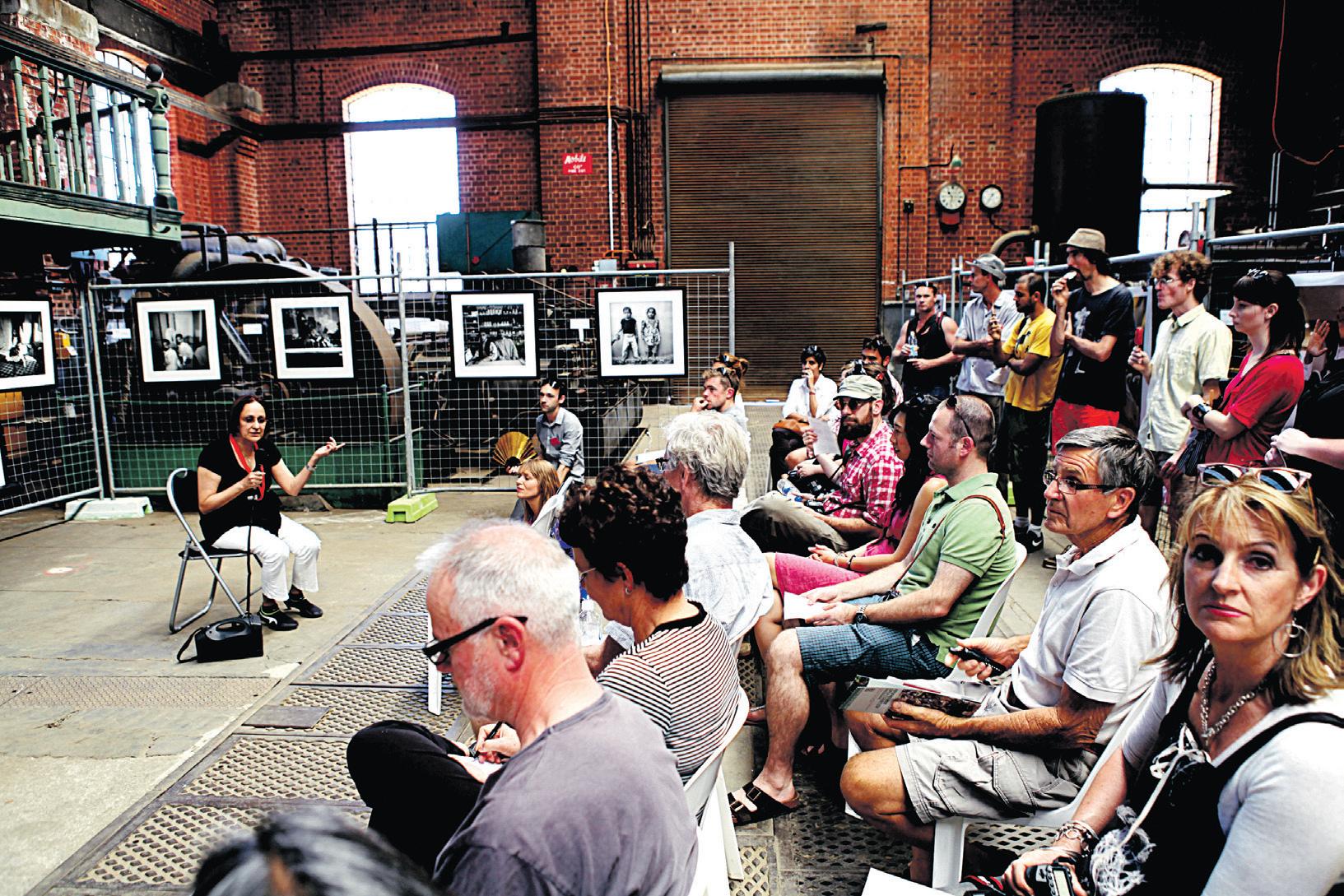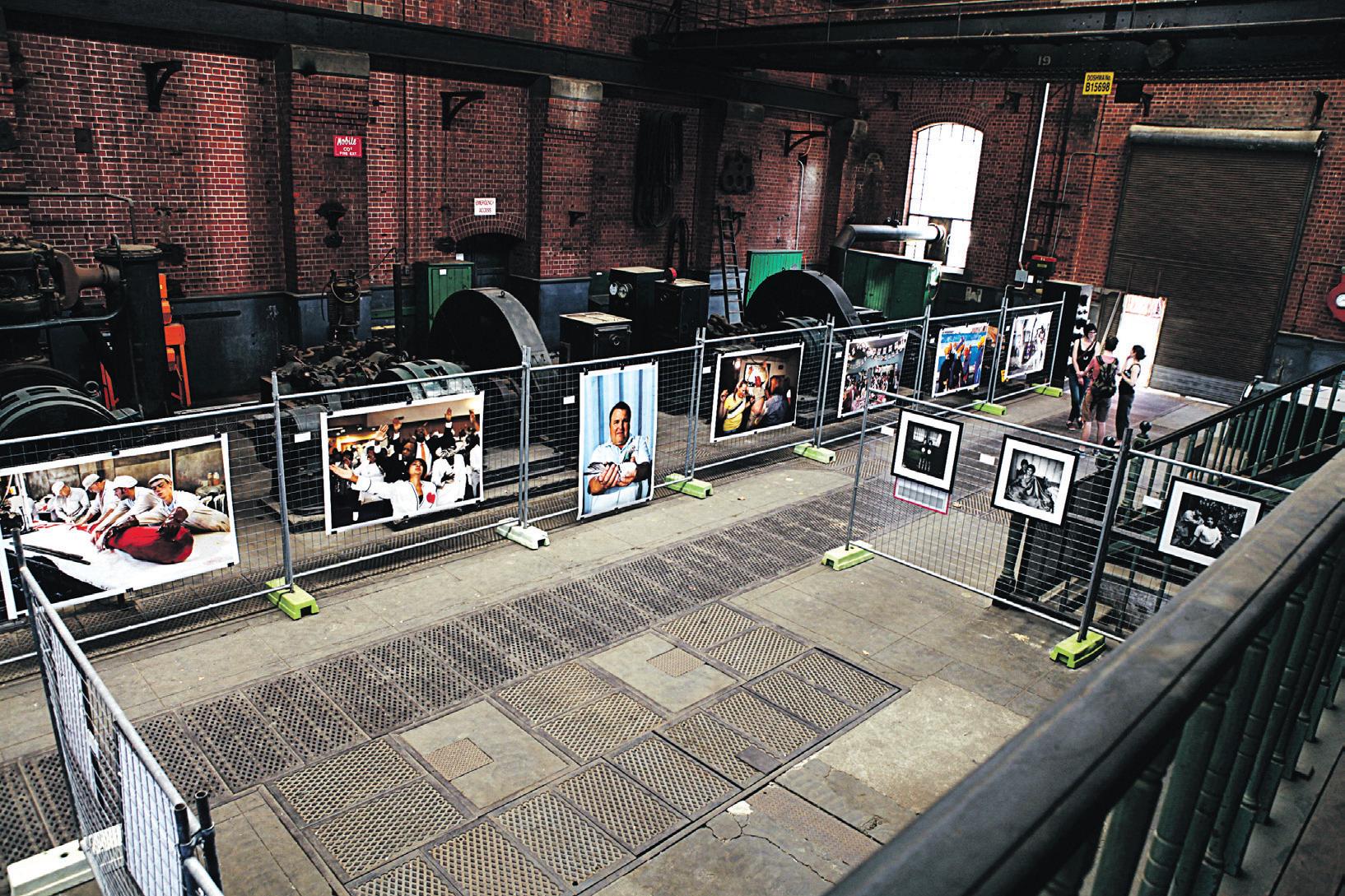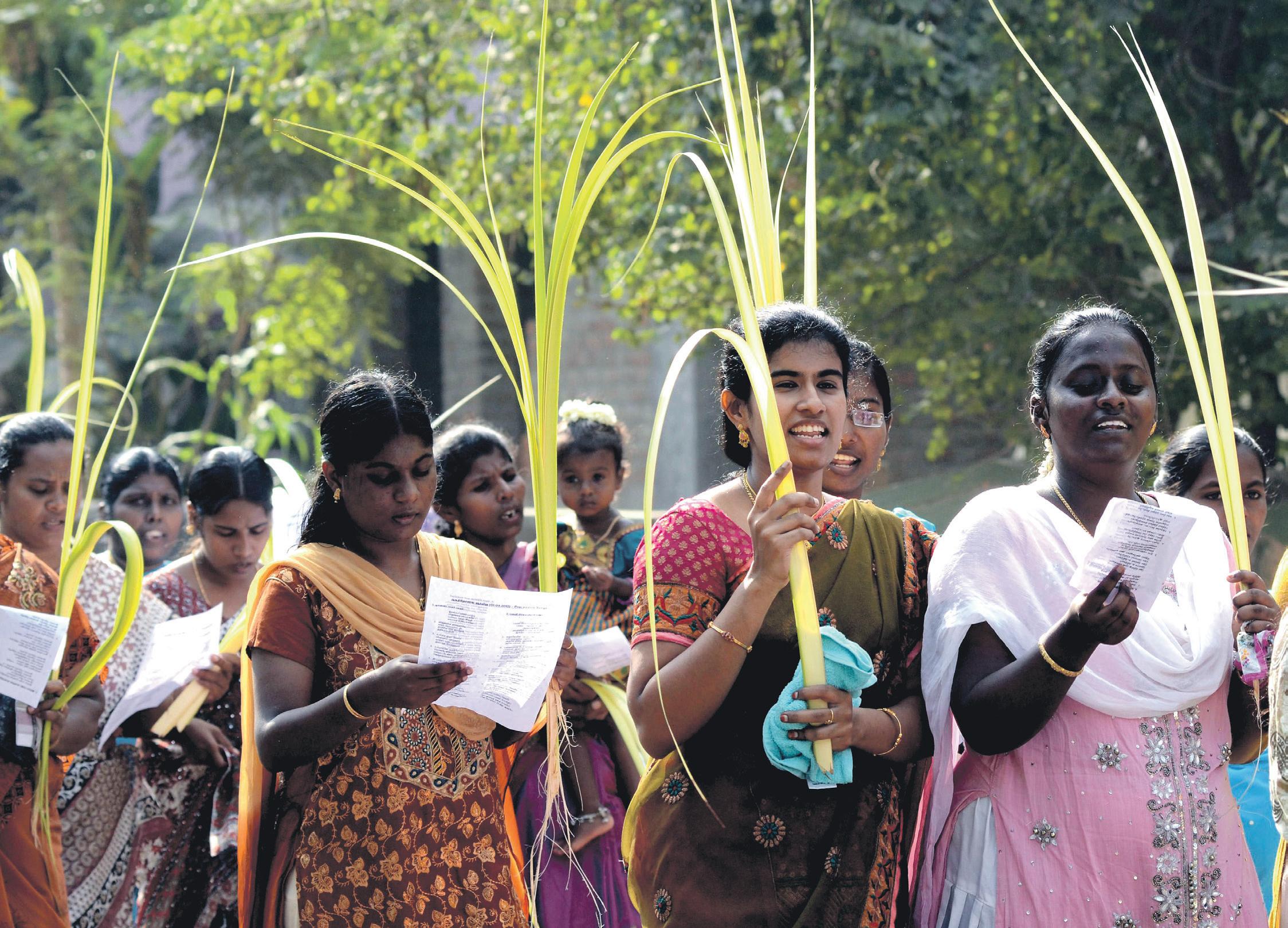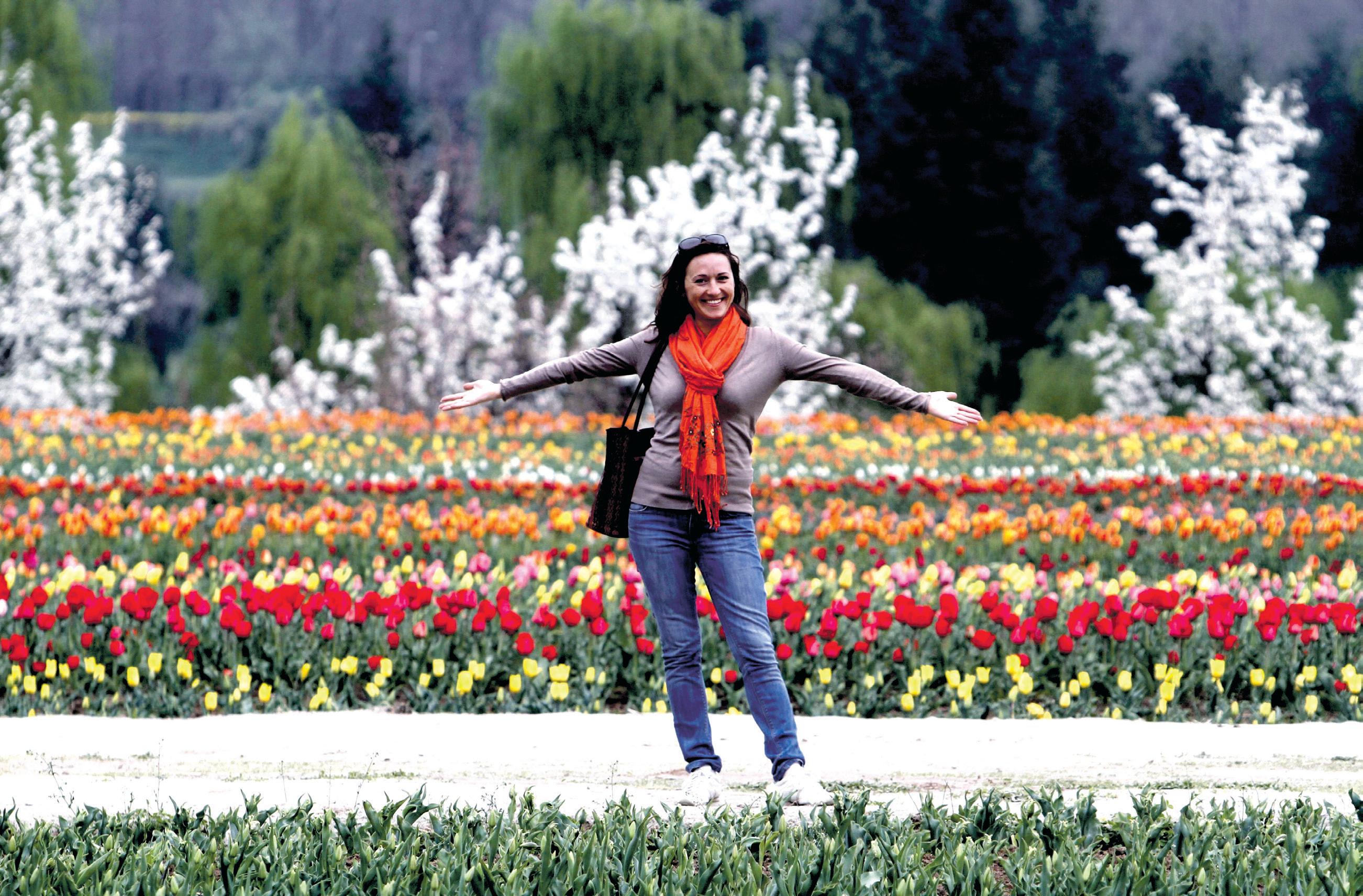
18 minute read
through Indian lens
from 2012-04 Sydney (1)
by Indian Link
Indian photographer Raghubir Singh. She is influenced by the work of photographers André Kertész, Henri Cartier-Bresson, Eugène Atget, Walker Evans, Lee Friedlander and Helen Levitt.
Sohrab Hura, the young emerging talent from the group exhibited work from his Benares, Holi and The Naga Sadhus at the Ardh Kumbh Mela series. Hura is a young photographer who has been lauded as one of India’s next generation talents. He is widely exhibited and has won three Indian Press Photo Awards, (Benares in 2006, Oasis and Holi in 2008), a China International Press Photography Award for Holi (2010) and he was a recipient of the Magnum Foundation’s Emergency Fund in 2010. Hura participated in an international residency for young photographers called Pour l’instant Rencontres de la jeune photographie internationale, at Niort, France.
After attending the opening, the photographers, accompanied by Devika Daulet Singh of Photoink, New Delhi, and yours truly as FORM Curator, travelled with the photographers to Karratha. The journey began from Point Samson to Roebourne, to Wickham, Port Hedland and Marble Bar.
Throughout the trip the photographers met Pilbara personalities, visited Aboriginal communities and commented on the truly multicultural nature of the region which comprises of 52 different nationalities. They were awed by the intensity of the light and were unable to shoot between 1- 4pm, and by the vast expanse of the land.
The trip gave the group a chance to experience first-hand a lesser known Australia, one that is unique and memorable. As Sheth commented, “The landscape was so stark and staggering, the people so compelling, the light so harsh and the distance from anywhere seemed interminable. But in retrospect, I feel all of this helped get into the heart of it.”
The photographs will be part of an exhibition and publication, which will tour Australia and India.
Throughout the trip the photographers met Pilbara personalities, visited Aboriginal communities and commented on the truly multicultural nature of the region which comprises of 52 different nationalities.
Divergence: Photographs from Elsewhere, a monumental showcase of photography by over 60 photographs from 15 countries, is on at the historic Midland Railway Workshops site (Yelverton Drive, Midland WA 6056) until 15 April. Ph 08 9226 2799
Top: Ketaki Sheth’s presentation at divergence: Photographs from Elsewhere
Below: The installation at the Midland Railway Workshops

Indian artist’s painting fetches $300,000 in US auction
A previously unrecorded work by the master Indian artist Bagta fetched a record $302,500 at the Indian, Himalayan & Southeast Asian Art auction in New York in March.
This portrait of the imposing figure of Rawat Gokal Das celebrating ‘holi’ with his consorts (fl. 1761-1814) was consigned by a collector who bought the piece two decades ago for a modest $125, according to New York auction house Bonhams.
Dated 1808 and measuring 16 x 22 inches this work is a rare representation of Bagta’s larger scale depiction.
Bagta was featured in the landmark exhibition which opened at the Museum Rietberg, Zurich, and was on display at the Metropolitan Museum of Art, New York’s ‘Wonder of the Age, Master Painters of India, 1100-1900’ exhibition until recently.
“It was truly incredible to witness the sale of this work come to fruition. Bringing in a lot of this calibre has proven to be not only a highlight of my career but also a highlight for Bonhams and for this 2012 Asia Week,” said Edward Wilkinson, Bonhams department specialist.
Indian-origin people close to being 1 in 100 Americans
People of Indian origin are close to making one percent of America’s population of 308.7 million with their numbers shooting up by a whopping 69.37 percent over the last decade.
Indians are now the largest Asian subgroup in 25 states in America, mainly in the South and Midwest, making them the main driver in population growth of Asian Americans, according to an analysis of US 2010 Census data by the California based India-West newspaper.
The New York-Northern New JerseyLong Island metro area had 526,133 Indian Americans in 2010, about 18.5 percent of the nation’s total of 2,843,391 with a dramatic increase in their numbers from 1,678,765 in 2000.
While California had the most Indian American residents at 528,176, and New York was second at 313,620. Indians have a higher percentage as a ratio of a state’s total population in New Jersey.
There are now 292,256 Asian Indians, as the Census Bureau terms Indian Americans, in New Jersey, 3.3 percent of the state’s total population. Indian Americans in New Jersey numbered just 169,180 in 2000, so their number has increased almost 73 percent.
The next states after the top three with the largest numbers of Indian Americans in 2010 were: Texas, 245,981; Illinois, 188,328, Florida, 128,735; Virginia, 103,916, Pennsylvania, 103,026; Georgia, 96,116; Maryland, 79,051; Massachusetts, 77,177; Michigan, 77,132; Ohio, 64,187; Washington,
61,124; and North Carolina, 57,400.
Indian Americans are the largest Asian group in six of the 10 largest metro areas in the US. These with their national rankings by population size listed in brackets were: Chicago (3), Dallas (4), Philadelphia (5), Washington, D.C. (7) Miami (8) and Atlanta (9).
The Indian American population increased due to several factors, including the influx of a large number of professionals, particularly those coming on H-1Bs, according to the India-West analysis.
India was also a leading source of foreign students from 2000-10. Many have stayed to continue their studies or to work in the country. Many others who immigrated to the US in the 1980s and 1990s have sponsored relatives under the family visas.
Another factor is the growth of small businesses run by Indian Americans, particularly convenience stores, hotels and motels and in the health-related fields.
Pakistan to protect Hindu temples
Pakistan is committed to protecting shrines belonging to minorities, a minister said recently in Islamabad, following a protest by Hindus over illegal occupation of a temple in Punjab.
Minister-in-charge for National Harmony
Paul Bhatti said all steps were being taken to maintain Hindu temples, Online news agency reported.
More than 30 Hindus from Zafarwal in Narowal district protested in front of the National Press Club here to seek an end to the occupation of the temple.
Bhatti said no one should be allowed to occupy places of worship of the minorities, and ordered authorities to resolve the issue at the earliest.
“Inter-faith harmony can only be achieved through inter-faith relationship. We should have interactions to understand each other’s point of views,” Bhatti said.
Punjabi museum opens in Yuba City
A multi-media museum celebrating more than 100 years of the Punjabi community in the US opened in the community-dominated Yuba City in California recently.
A brainchild of the Punjabi American Heritage Society (PAHS), the multimedia museum, the first of its kind in the US, highlights the contribution of the Punjabi community to the social fabric of their adopted land.
``The museum is a multi-media record of the challenges and successes of generations of Punjabi Americans. It documents the hardships they faced on their arrival in California in the early twentieth century and their journey to ‘Becoming American’,’’ said prominent community leader Jasbir Kang.
In his message to the community on the occasion, California Governor Jerry Brown said, “Showcasing the story of the Punjabi American and South Asian migration to the United States is a valuable and needed resource for current and future generations.
``I congratulate all the individuals and families along with the Punjabi American Heritage Society of Yuba City for their dedication and hard work for the successful completion of this project.”
California assembly members Jim Nielsen and Dan Logue, County Supervisors Jim Whiteaker, Larry Munger and Stan Cleveland, Yuba City Council member Tej Mann and former Yuba City mayors Kash Gill and Rory Ramirez were among the hundreds who attended the opening ceremony.
In a press release, the organizers said: ``Since 9/11, Sikhs and South Asians have borne the brunt of mistaken identity by racist attacks, assaults and even murder. Through this exhibit, PAHS tells the story of Punjabis that have a long tradition of contributing to the success of their local communities.
``The story of the Punjabis, the Sikhs and the South Asians is the same as that of the Irish, the Italians and the Polish before them; it is an American story.’’ Yuba City was one of the first destinations of Punjabi immigrants to the US in the early 20th century.
Known as Punjab da Pind, the city has the largest concentration of the Punjabi community in the US and boasts many gurdwaras, temples and even a mosque.
Indian American student among wounded in US shooting
A gunman who killed seven people at a California University ordered everyone to get up against a wall, and started shooting, according to a 19-year old Indian American student who was among the three wounded.
Davinder Kaur, 19, a US Army Reservist from Santa Clara, told relatives the gunman had been a student in her class but had been absent for months before reappearing the fateful morning, Oakland Tribune reported.
“The people started running, and he started shooting,” said Gurpreet Sahota, who relayed an account from his sister-in-law, a nursing student.
Some panicked when he drew a gun and began firing; she was shot in the arm as she helped a friend who had fallen on the classroom’s floor. She then ran outside and called her brother, Paul Singh.
“She told me that a guy went crazy, and she got shot,” Singh said. “She was running. She was crying; she was bleeding. It was wrong.”
Police received a 911 call at 10.33 a.m. Art Richards, of Oakland, told the Tribune he arrived at the school right around that time to pick up a friend who’s a nursing student there.
Richards said he saw a young woman wearing blue scrubs -- possibly Kaur -emerge from bushes near the building, with blood running down her right arm from a wound near her elbow.
She told him the gunman had fired point-blank at a man’s chest, and she had been grazed by a bullet before she fled the building.
Kaur’s family, standing vigil as she was being treated at Alameda County Medical Center’s Highland Hospital, said they saw other victims as well: a man shot in the shoulder and a woman shot in her hand and back.
Kaur’s father, Balvir Singh, via translation by Sahota, said her family is “lucky she is alive. We are thankful that God saved her.” The gunman, he said, “should get the full consequences that he deserves for doing this to these people.”
Oakland Police have arrested the alleged shooter identified as 43-year-old One Goh, an American of Korean origin.
Custody row: Norway to hand over children to their uncle
Uncertainty over the custody of two NRI children who have been taken into foster care in Norway on grounds of alleged negligence by their parents seems to be over with the Norwegian authorities agreeing to hand over the kids to their paternal uncle Arunabhash Bhattacharya, a family member said.
“The (Norway) Child Welfare Service (CWS) has informed that the children, Abhigyan and Aishwarya, will be handed to Arunabhash on April 17 after conclusion of the court hearing on the issue,” Ajay Bhattacharya, grandfather of the children, told IANS over phone.
“The April 17 court hearing was earlier cancelled over the reported differences between my son Anurup and his wife Sagarika (parents of the children), but the matter has been resolved, and the hearing will take place as slated where the custody of the kids will be handed over to their uncle,” added Ajay Bhattacharya.
After the Indian government’s intervention, the authorities had agreed to recommend to a court in Norway March 23 that the children be placed in the custody of their uncle Arunabhash.
However, that did not happen following reports of marital discord between the parents of the children.
The kids, aged three and one, were taken away from their parents by the child welfare service of the local municipality and placed under emergency foster care in May 2011.



Christian devotees in Chennai hold palm leaves as they take part in a religious procession to celebrate Palm Sunday, 1 April 2012. The Sunday before Easter is known as Palm Sunday. It celebrates Jesus’ arrival in Jerusalem for the Jewish festival of Passover. Traditionally people lined the streets and waved palm branches to welcome him and devotees spread branches on the road.

Antony asks army to streamline acquisitions
Amid allegations of bribery, Defence Minister A.K. Antony recently asked the army to streamline its purchase process in a manner that accountability can be fixed in the event of slippages.
This was conveyed by Antony to the army brass led by its chief Gen. V.K. Singh at a meeting to finalise the army’s capital acquisition proposals at the South Block in New Delhi.
This is the first time Antony and Gen. Singh came face-to-face since the acrimony over the army chief’s allegation of a bribe offer made to him by a retired officer and the leak of a secret letter from him to Prime Minister Manmohan Singh on gaps in defence preparedness.
The meeting was in continuation of earlier review meetings held in September last year and January.
“At the meeting, Antony directed the army to streamline its acquisition process in such a manner that accountability can be fixed in case of any slippages,” a defence ministry spokesperson said here.
Antony also asked officials of the defence ministry and the army to examine the possibility of compressing the time taken for technical evaluations and trials.
It is assessed that the services and the defence ministry take about seven years for completing the procurement processes of any major equipment.
He favoured delegation of more financial powers to the service headquarters if it can lead to speedier acquisition of equipment, platforms and systems for the services.
At present, the services vice chiefs can approve defence contracts worth Rs.50 crore or less.
The other competent financial authority for defence acquisition are the defence secretary for deals worth Rs.75 crore, defence minister Rs.500 crore, defence ministry in concurrence with the finance minister for Rs.1,000 crore, and the cabinet committee on security (CCS) above that.
Among those at the meeting were Defence Secretary Sashi Kant Sharma, Director General (Acquisition) Vivek Rae and senior army officials.
Among the major army acquisitions that are pending are the Rs.20,000-crore (over $4 billion) worth of artillery guns to replace the ageing inventory and air defence weapons.
Gen. Singh had, in his latest letter to the prime minister written in March, pointed out that the army had major gaps in its air defence, artillery, night vision capabilities and infantry.
In an unrelated event, the army chief had given an interview to the media in which he claimed that a retired lieutenant general had offered him a bribe of Rs.14 crore for approving a contract for 600 trucks for the army.
Both the developments had caused a major uproar in parliament. Some political parties wanted the army chief to be sacked.
The Intelligence Bureau has been asked to find out who leaked the letter from the army chief to the prime minister.
India further eases defence offsets norms
India recently further eased its defence offsets norms, saying the value of technology transferred under a deal could be written off against the obligation to reinvest 30 percent of all contracts over Rs.3 billion ($75 million). The offsets clause is expected to bring in investments of $30 billion over the next decade.
Under the Defence Procurement Procedure that was last amended in 2011, a firm winning a defence contract in India worth over Rs.3 billion will have to mandatorily plough back 30 percent of the deal amount in Indian defence, aerospace and homeland security industries.
This provision is a common practice by several nations which make defence purchases from foreign countries.
“The revised policy recognises TOT (transfer of technology) as eligible for discharge of offset obligations,” the revised provisions of offsets clause approved at the Defence Acquisition Council meeting chaired by Defence Minister A.K. Antony said.
The revised provisions also make a distinction between equity and non-equity route, that is investment in “kind” made by the original equipment manufacturer (OEM) for discharge of offset obligations.
“Investment in kind in terms of TOT must cover all documentation, training and consultancy required for full TOT (civil infrastructure and equipment excluded),” the salient features of the new defence offset guidelines said.
The TOT, it said, should be provided without licence fee and there should be no restriction on domestic production, sale or export. The offset credit for TOT shall be 10 percent of the value of buy back by the OEM during the period of the offset contract, to the extent of value addition in India.
The guidelines also noted that the technology acquisition by Defence Research and Development Organisation (DRDO) for a list of specified technologies will be treated as an eligible offset with a multiplier up to three.
It has already been decided to allow the tier-I sub-vendors under the main procurement contract to discharge part of the offset obligations on behalf of the main vendor. However, the overall responsibility for discharge of the offset obligations shall rest solely on the main vendor.
Now, the agreement between the OEM, vendor and tier-I sub-vendor and the Indian offset partner will mandatorily be subject to Indian laws.
In the earlier policy, offset guidelines have to be discharged during the period co-terminus with the main procurement contract. The revised guidelines allow offset obligations to be discharged within a time frame that can extend beyond the period of main procurement contract by a maximum period of two years.
The overall cap on penalty will be 20 percent of the total offset obligations during the period of the main procurement contract. There will be no cap on penalty for failure to implement offset obligations during the period beyond the main procurement contract, which may extend to a maximum period of two years.
Under the existing guidelines, banked offset credits were valid for a period of two years. The period of validity has been increased to seven years under the revised guidelines.
In the discharge of offset obligations relating to direct export, foreign direct investment and technology transfer or investment in ‘kind’ in Indian enterprises through non-equity route, a multiplier of 1.50 will be permitted where micro, small, and medium enterprises (MSME) are the Indian offset partners. The monetary limits specified by the Indian government’s department of MSME shall be applicable for identification of the MSME.
“In exceptional cases, the competent authority may permit change in offset partners or offset components provided the value of offset obligations remains unchanged. This will provide greater flexibility in implementation,” the guidelines said.
US urges India to press Iran over nuclear issue
Downplaying divergences on the Iranian issue after imposing fresh sanctions, the US recently sought India’s cooperation in pressing Tehran to come clean on its nuclear programme and clarified that it was not seeking to undermine New Delhi’s energy security.
US Undersecretary of State for Political
Affairs Wendy Sherman met Foreign Secretary Ranjan Mathai here on a range of issues that focused on setting the agenda for the forthcoming strategic dialogue between External Affairs Minister S.M. Krishna and US Secretary of State Hillary Clinton in June.
Sherman also met National Security Adviser Shivshankar Menon and discussed closer collaboration in combating terrorism and issues related to the AfghanistanPakistan region, informed sources said.
The US lauded India’s reconstruction efforts in Afghanistan and promised not to allow that country to become a safe haven for international terror.
The Iranian nuclear issue figured prominently in the discussions.
India conveyed its concerns over the proposed US sanctions against Iran which has the potential to undermine India’s energy security as it imports around 10-12 percent of its oil from Tehran, said the sources.
The US appreciated India’s position and agreed with New Delhi that space should be created for dialogue to resolve the Iranian nuclear issue.
“Recently, the press has asserted that our two countries have divergent views on Iran. Let me correct the record. Our countries share the same fundamental goals: preserving regional stability and preventing Iran from acquiring a nuclear weapon,” Sherman said at the American Centre here.
“Achieving these goals will require making hard choices. We recognize India’s historical linkages with Iran and Persian culture and understand its interest in developing Iran as a gateway to Afghanistan and Central Asia,” she said.
Sherman, however, made it clear that although the US was serious about “a diplomatic resolution” of the Iranian nuclear issue, it has “made clear publicly and privately that we believe there is time and space for diplomacy, though that time is not unlimited”.
Sherman assuaged India’s worries about the impact of the US sanctions against Iran and sought New Delhi’s leverage to persuade Tehran to dispel fears about its nuclear programme.
“We do not seek to undermine India’s energy security; however, India’s partnership and willingness to press Iran to fulfill its international obligations is essential for international efforts to be successful,” she said.
The US recently granted an exemption from punitive sanctions to 10 European nations and Japan for significantly reducing oil imports from Iran.
India does not figure in this list. India has made it clear that it will abide by the UN sanctions but is not bound to accept unilateral sanctions.
Welcoming the recent elections in Myanmar which saw Aung San Suu Kyi winning a parliamentary seat, the US also sought closer collaboration with India to encourage reforms and national reconciliation in that country.
“Though only a small number of parliamentary seats are at stake, with the inclusion of Aung San Suu Kyi and the NLD, today’s events mark the first opportunity for many Burmese voters to participate in a genuine multi-party election,” said Sherman.
“Despite our past differences, I hope we can work with India to foster this opening in Burma and build a brighter future for its citizens,” she said.
Structural, administrative reforms needed for developing education: Sibal
Regretting that 14 legislations, including the Educational Malpractices bill and Foreign Education providers bill, were pending in parliament, Human Resource Development (HRD) Minister Kapil Sibal recently said structural and administrative reforms are needed for development of the education sector in India.
“We have introduced about 14 legislations in parliament. They are all pending in parliament, and for two years. Nobody wishes to debate them, nobody wishes to put them on the agenda. So if the policy framework becomes paralysed, because the political processes don’t allow the education to be looked at elaborately, then how do we move forward?” said Sibal, speaking from Kolkata.

“We (UPA) don’t have majority in the Rajya Sabha. So if somebody says we will not allow the bill to come on the agenda what can we do? How do we pass the Educational Malpractices bill, Foreign Education providers’ bill?” he said.
The seasoned politician pointed out that 10 years from now, people are going to ask about these facilities.
“By 2020, 100 million additional people will be part of the workforce from India only. By 2030 one third of world’s workforce will be provided by India. It’s going to be demand driven, and they are going to ask what we did,” he said.
Sibal stated there is a need for structural and administrative reforms and a collaborative approach for development of the education sector.
The minister said he expected the National Vocational Qualification Framework to be introduced in 2012 academic year. The matter is likely to be placed before the cabinet in the next three to four weeks.
Hyderabad airport gets greenhouse certification
The Rajiv Gandhi International Airport (RGIA) in Hyderabad has received ISO 14064 certification, becoming the second airport in India and the third in Asia to complete verification of greenhouse gas emissions.
The airport successfully accredited its greenhouse gas (GHG) inventory including greenhouse gas emissions and removals for reporting years 2009 to 2011, according to the ISO 14064-1:2006 specification.
Bureau Veritas conducted independent audit and issued the verification statement, said a release from GMR Hyderabad International Airport Ltd (GHIAL), which operates the airport.
The verification of GHG inventories helps RGIA in reducing its carbon intensity, which is carbon footprint per passenger or per tonne of cargo handled, cost of energy and meet GHG accounting international norms in aviation sector.
RGIA is not just a greenfield airport but a green airport primarily developed on eco-friendly concepts, said the statement.
Advent invests $105 million in CARE Hospitals
Advent International, one of the world’s leading global private equity firms, recently announced that it is investing $105 million (Rs.523 crore) in Hyderabad-based CARE Hospitals by acquiring shares from existing investors.
The business will continue to be run by the founders following Advent’s investment, said a statement from Advent International. CARE is the largest multi-specialty hospital chain in south India. It is ranked five by number of beds and by revenue in India, and has a significant market position in Andhra Pradesh.
“From a 100-bed single specialty facility focusing on cardiac care, CARE has become a multi-specialty hospital group comprising 1,590 beds across 11 hospitals. Our partnership with Advent provides us with the required resources and support to expand our presence and reiterates our commitment in providing the best in healthcare with compassion, to more people in India,” said CARE Hospitals founder B.Soma Raju.
“Through this union, Advent brings relevant global experience to support CARE’s expansion plans in India. CARE aspires to match the best international benchmarks in healthcare delivery and we are committed to supporting them in this endeavour,” said Georg Stratenwerth, managing director, Advent India PE Advisors Pvt Ltd.
CARE has hospitals in Vishakhapatnam, Raipur, Bhubaneshwar, Nagpur, Surat and Pune along with Hyderabad, and is poised for further growth and expansion in tier II cities, added the release.
Need to sensitize society on autism
Minister of Social Justice and Empowerment Mukul Wasnik recently said there was an urgent need to sensitise the society about autism to ensure a dignified life for India’s 10 million autistic people. Wasnik was speaking at a workshop organised by the National Trust for Welfare of Persons with Autism, Cerebral Palsy, Mental Retardation and Multiple Disabilities to mark World Autism Day in New Delhi.
Worldwide, April 2 is celebrated as the World Autistic Awareness Day. Autism is an incurable condition that impacts communication, behaviour and social relationships and affects 1 in 110 people.
“Ten million is a big number. It is time we sensitized all the stakeholders of civil society,” Wasnik said.
Wasnik also laid emphasis on the importance of improving special education systems for people with disabilities.
“It is time we got academics, disability experts and the ministries of social justice and human resource development to come together so that there is no confusion,” he said.
Wasnik announced that a national festival for people with disabilities will be held in September.








